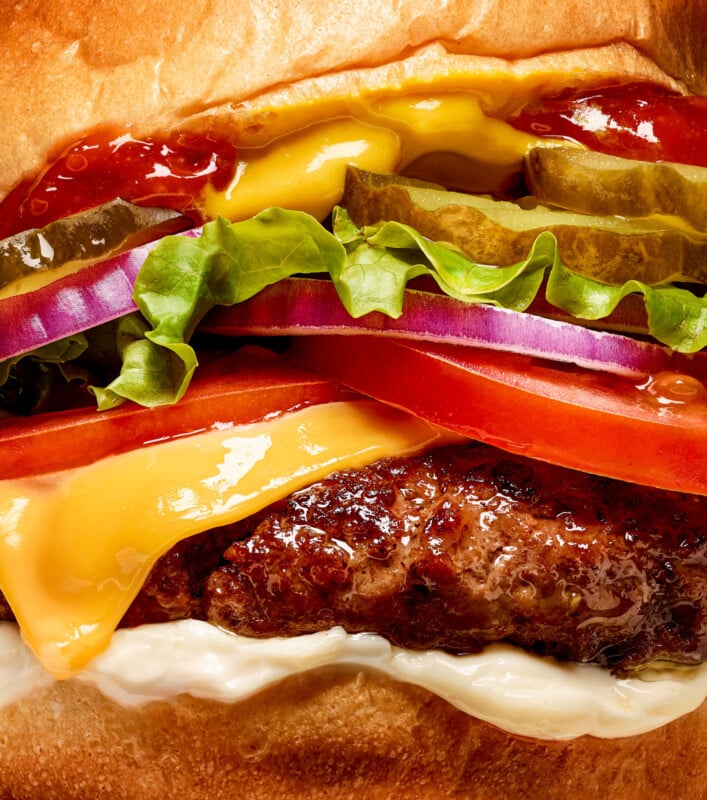![]()
Everyone has an intimate relationship with food. The job of food photographers, says an award-winning pro, is to create images that connect food’s personality to people who consume it.
Andrew Burkle, lead creative and partner at Cleveland-based BurkleHagen Studio, shares behind-the-scenes strategies for effective food photography and meeting clients’ expectations.
 Andrew Burkle
Andrew BurkleBurkleHagen is a high-end commercial 6,000-square-foot studio specializing in food photography and videography. Clients include Burger King, Nestle, Popeyes, Olive Garden, Doritos, Marriott, Hormel Foods, and Outback Steakhouse. The studio creates advertising assets for print, web, social, and broadcast media.
“Food is tied inextricably to culture. Shooting food is an active still life,” says Burkle, founder and chief of photography at the studio since 2014.
 Chocolate orange espresso cake | Photo by Andrew Burkle. Food stylist: Laura Goble. Talent: Alana Maura.
Chocolate orange espresso cake | Photo by Andrew Burkle. Food stylist: Laura Goble. Talent: Alana Maura.Lighting
In food photography, the contrast quality of light is more intense compared to other genres, such as lifestyle or portraits.
“I need to light the food in a way to accent the parts of the item that is most appealing. We use backlighting and hard light to give shape and dimension to these small objects,” Burkle says.
 Classic cheeseburger | Photo by Andrew Burkle. Food stylist: Claire Vredevoogd.
Classic cheeseburger | Photo by Andrew Burkle. Food stylist: Claire Vredevoogd.If done well, lighting can invoke emotions as well as a sense of place, time of day, and mood.
“The goal for us,” says Burkle, “is to take the viewer somewhere else, and not just seen as an item shot in a studio with strobes. We have dozens of strobe heads and plenty of different modifiers to help shape the light. We use flags and scrims to create drama in the image and focus your attention on the subject.”
The Important Role of Food Stylists
The challenge in food photography, says Burkle, is to invoke human emotion when shooting still life.
“The answer is in the details,” he says. “We need to have a great food stylist who can build the product with personality. The set and props need to convey a feeling, or sense of place.”
“Food stylists are our resident experts. If you wanted to be a successful fashion photographer, you’d need to know current and historical trends in fashion. Shooting food is the same way. Food stylists know how to properly prepare food and properly present it. They are also partners in problem solving; food stylists create the subjects which we shoot. Trust, skill, preparation and experience that food stylist bring to set cannot be compromised at our studio, it is that important.”
 Classic portrait lighting on the talent and hard backlighting for the cocktail. | Photo by Andrew Burkle. Food stylist: Ryan Morrow. Hair and makeup: Liz Cook. Wardrobe: Magan Mclaughlin.
Classic portrait lighting on the talent and hard backlighting for the cocktail. | Photo by Andrew Burkle. Food stylist: Ryan Morrow. Hair and makeup: Liz Cook. Wardrobe: Magan Mclaughlin.Equipment
BurkleHagen uses Fujifilm GFX100 II medium format cameras, Sony a1 and a7R V mirrorless 35mm cameras.
 Red V-Raptor on a Dana dolly with a live feed of the set
Red V-Raptor on a Dana dolly with a live feed of the set“For motion, we shoot with a Red V-Raptor. For still lighting we use Profoto strobes, and for motion we use Aperture LED lights. We have a wide range of lenses, but each camera system has at least one dedicated macro lens which is best for shooting food,” Burkle says.
 Behind the scenes of an internal portfolio shoot. Andrew Burkle records a video with the Red V-Raptor.
Behind the scenes of an internal portfolio shoot. Andrew Burkle records a video with the Red V-Raptor.Do Photographers Taste-Test Food?
Absolutely! “Being well versed with the product is a must.”
We often have long conversations with clients about how the product came to be and who is the target audience,” Burkle explains. This knowledge, along with taste-testing, helps shape food styling and lighting.
 Overhead shot of Korean Banchan and side dishes served with rice. | Photo by Andrew Burkle. Food stylist: Claire Vredevoogd.
Overhead shot of Korean Banchan and side dishes served with rice. | Photo by Andrew Burkle. Food stylist: Claire Vredevoogd.Credentials
BurkleHagen has been honored by local, regional, and national ADDY Awards, plus recognition from American Photographic Artists (APA), Communication Arts, KelbyOne, and PDN.
In 2008, Burkle won College Photographer of the Year in the illustration category. He earned a degree in commercial photography from the School of Visual Communication at Ohio University.
Image credits: All images © Andrew Burkle / BurkleHagen
About the author: Ken Klein lives in Silver Spring, Maryland; he is retired after a career in politics, lobbying, and media including The Associated Press and Gannett in Florida. Klein is an alumnus of Ohio University and a member of the Dean’s Advisory Council of the Scripps College of Communication. Professionally, he has worked for Fort Myers News-Press (Gannett), The Associated Press (Tallahassee), Senator Bob Graham, and the Outdoor Advertising Association of America (OAAA).








 English (US) ·
English (US) ·